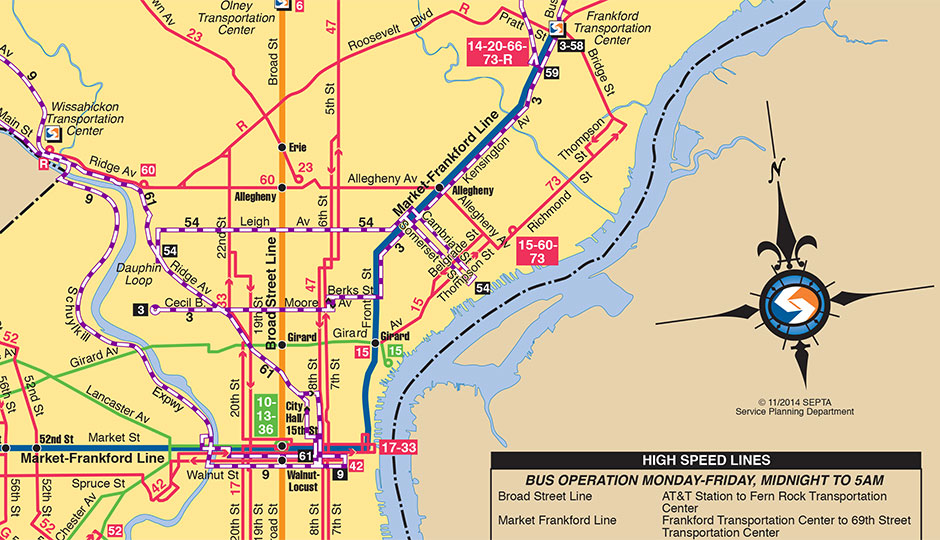MAP: This Is What Philly Would Look Like With Full 24-Hour SEPTA Service
We asked them about Manayunk, East Oak Lane and the Great Northeast. So they drew us a map. They want to know your ideas, too.

We gave SEPTA some suggestions for all-night bus routes. They showed us what that might look like.
If you read my first commentary on all-night SEPTA subway service — in which I asked if SEPTA might better spend its money providing 24-hour bus service to all corners of the city — you may be surprised to hear that I was quite pleased when the agency decided to make its experiment with all-night rapid transit on weekends permanent.
And it’s not just because it means I can now take a train rather than a bus home on those occasional weekend nights that I stay out way late. Rather, it’s because it shows the agency responded to its riders. A bunch of them recommended this change, SEPTA tried it, and the riders responded enthusiastically.
And the agency is providing this service, which is carrying anywhere from 66 to 100 percent more riders than took the Nite Owl buses, for a mere $34,000 more per weekend than it spent on the buses.
That’s $1.768 million for a year’s worth of overnight subway-elevated service on the weekends.
But.
There’s still this nagging feeling in the back of my head that this $1.8 million or so would still be better spent providing overnight service to parts of the city that don’t have any — or are too far from the nearest — 24-hour bus line.
To put a personal spin on this, I’m one bus — and 90 minutes — shy of having 24-hour service from Center City all the way to my home. Worse still, people in places like Roxborough or Bustleton are just plain out of luck from roughly 1 a.m. to 5 a.m.
So I passed my complaint on to Manuel Smith in SEPTA media relations.
And damned if he didn’t take it seriously. So did the Service Planning Department, which ran the numbers on the routes I suggested should run all night. They’re indicated with dashed lines on the map below.
(Use the slider to compare existing service with our proposal.)


How much would it cost to run these bus routes all night, every night?
$1,829,192 per year, according to Smith. That’s not much more than it costs to carry an additional 6,000 riders on average on the Market-Frankford and Broad Street lines each weekend.
The question then becomes: Would we get similar bang for the buck if SEPTA took my advice?
Here’s where the rubber meets the road, so to speak.
Take one of my prime candidates for all-night operation, Route 9 (left), which serves Roxborough, part of the largest section of the city without overnight service.
“There’s a service gap on weekdays from 12:30 to 5 a.m., true,” said Smith. “But the 9 is more of a commuter route. A lot of people are riding it at 5 p.m., but as you reach the end of the day, the buses are far from packed.” In fact, SEPTA classes this route internally as a city route with “suburban” characteristics — and save for the 109, none of SEPTA’s suburban bus routes run all night. Running just the 9 all night would cost almost $588,000 a year, almost one-third of the total cost of running all of my proposed owl service additions.
Similarly, Smith said, “Getting to Manayunk late nights isn’t an issue that came up very often” when SEPTA asked riders to suggest service improvements, something it does every year as part of the Annual Service Plan process. Extra late-night trains on the Manayunk/Norristown Regional Rail line pretty much take care of demand, and even I will allow that Route 61, which does a slow, frequently late crawl up Ridge Avenue, is a pretty weak way to provide all-night service to the area.
Some of the routes on this list once ran 24/7, most notably the 18 (left), for which SEPTA received federal grant money to operate the service. Once the grant ended, Smith said, the agency looked to see whether it was worth spending its own money to keep service alive. “There were something like 10 people who used that extra overnight trip”— so it got axed.
And this may be the problem with every one of the lines on the second map: They’re too close to existing all-night lines, like the 3, which runs under the Market-Frankford Line for half its length, or they’d get too few riders — the reason that the 39, the geographically logical route to fill the hole between the 15 and the 60 in North Central Philadelphia, isn’t on this map.
“We’re serving thousands of riders with that extra money,” Smith said of the overnight subway service. “Not just a few.”
And as the maps should show, there are lots of places in the city where SEPTA runs good overnight service. West and South Philadelphia especially are well served, though there’s a gap in the south that the Route 64 bus might fill, and there are even points in the Northeast and Northwest you can get to at any hour of the day.
But SEPTA is serious about getting input from riders about ways to improve service. Hundreds of proposals for route changes and new service get a going-over each year as part of the Annual Service Plan. “A record number of people contributed ideas to the Annual Service Plan last year,” Smith said. And a lot of them, he added, had a recommendation for an addition to the all-night network not on either of these maps: Route 65, the bus that connects Germantown with 69th Street Terminal via Wynnefield and Overbrook.
Service Planning is in the middle of the process now, and Smith assured me that any feedback I got on these proposed gap-fillers in the 24-hour service network would be taken into account and reviewed along with all the others.
So what say you? Would you use any of these routes if they were to run all night? I know that on my occasional nights out on the town, I’d use that missing 18 run, but are there enough other riders like me out there? A new report at Pacific Standard suggests that SEPTA’s 24-hour service is benefitting much more than just late-partying millennials. Do you have others to add to the list? Let me know in the comments. I’ll make sure that Service Planning sees them — and let you know whether any of these make it into the Annual Service Plan.
Follow Sandy Smith on Twitter.


